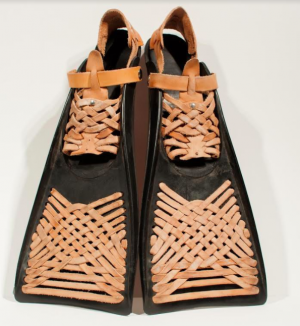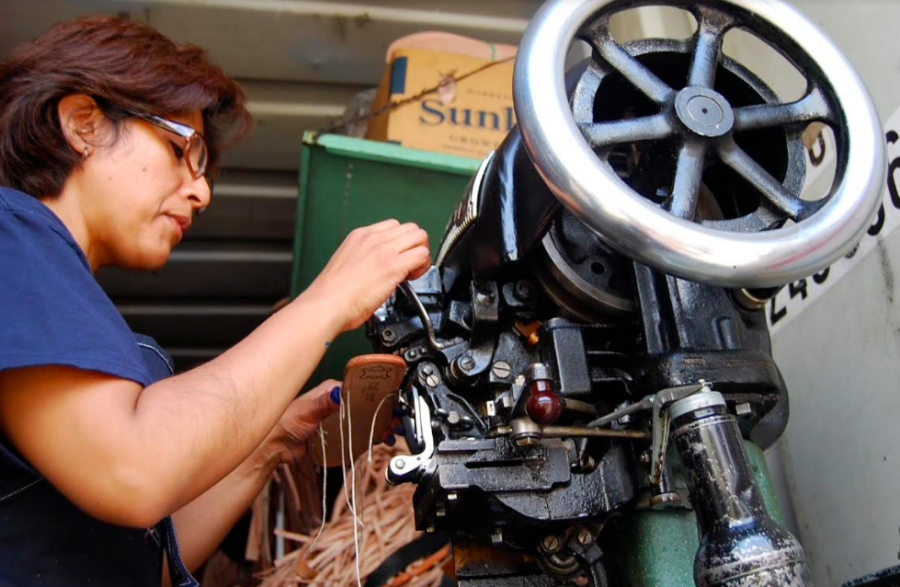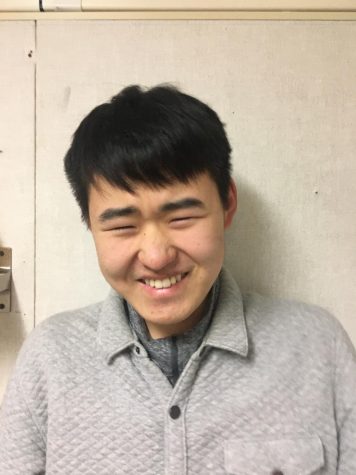Meet your teacher: Art teacher features original work at Getty-sponsored exhibition
In this repeating Features segment, the Winged Post profiles an upper school faculty member. This issue, Ms. Agüero-Esparza discusses her upcoming exhibition as well as her inspiration for her work.
Courtesy of Pilar Agüero-Esparza
Agüero-Esparza uses a sewing machine to fashion traditional Mexican sandals, known as Huaraches.
October 12, 2017
 When she was a child, upper school visual arts teacher Pilar Agüero-Esparza would always receive art supplies as holiday gifts and birthday presents, leading to a lasting passion for drawing, painting, and sculpture.
When she was a child, upper school visual arts teacher Pilar Agüero-Esparza would always receive art supplies as holiday gifts and birthday presents, leading to a lasting passion for drawing, painting, and sculpture.
“It’s funny but, still growing up, I was the the kid in my family who always got the box of crayons or the spirograph set,” Agüero-Esparza said. “I was drawing a lot when I was growing up, so I would get those kinds of gifts.”

Agüero-Esparza’s handmade Huaraches are on display.
Agüero-Esparza’s work is currently displayed at the Craft & Folk Museum as part of an exhibit titled “The US-Mexico Border: Place, Imagination, and Possibility.” The exhibit focuses on contemporary art from various disciplines such as design, architecture, sculpture, painting and photography. The exhibit explores the “issues related to emigration, immigration, labor condition, hybrid identities and transformation” according to Pacific Standard Time: LA/LA, the organization hosting the exhibition.
For the exhibit, Agüero-Esparza decided to go back to her roots and explore shoemaking. Agüero-Esparza’s family lived in Los Angeles when she was young, and her parents were shoemakers that made Huaraches, which are a type of traditional mexican sandals. During the summer, she would help her parents make and sell the shoes at flea markets.
“I grew up in a shoe shop all my life. That’s how they put us through school,” Agüero-Esparza said. “They would have this little shop, and in that shop, besides repairing shoes, what they really were doing was manufacturing mexican sandals. So the production of how to make shoes was something that I had around me, the smell of leather. [I] realized in a lot of ways I needed to go back to that source.”
For her project, Agüero-Esparza did a residency with her parents in order to learn about and take the practices of her parents and add her own touch as an artist. She also wanted to commemorate her parents’ stories.
“ I think it opened myself,” Agüero-Esparza said. “I left Los Angeles to come up north to go to school when I was eighteen, so I really hadn’t been living consistently there. I’d spend summers, I’d go back from time to time, but I pretty much have lived here, in Northern California, so It was kind of a bit of a homecoming, but also something that was a personal evolution in [my] relationship with my parents.”
Agüero-Esparza’s most memorable moment during her time working on the project was experiencing an earthquake during one of her interviews after she had dreamt of an earthquake months beforehand.
“ I kept dreaming that I was in the shop and that there’d be an earthquake, and I’d be in there with my daughter, and we’d be crushed,” Agüero-Esparza said. “So here we are, in the middle of the interview, and then the building starts to shake. It wasn’t a crazy earthquake, but it was beautiful, in a lot of ways. It was a little boom, and then the room shook a little bit, but it was the fulfillment of my dreams.”
For Agüero-Esparza, the project also serves as a lasting memory of her with her parents, who have both died since she completed the project.
“A year after we did the project, my mother passed away, so it was just in time, before we wouldn’t be able to have her participate in it,” she said. “And then, just this past summer, my father passed away, so having the little video that we made documenting the project that is part of that exhibit, it’s a little bit bittersweet.”
This piece was originally published in the pages of The Winged Post on October 12, 2017.


















![“[Building nerf blasters] became this outlet of creativity for me that hasn't been matched by anything else. The process [of] making a build complete to your desire is such a painstakingly difficult process, but I've had to learn from [the skills needed from] soldering to proper painting. There's so many different options for everything, if you think about it, it exists. The best part is [that] if it doesn't exist, you can build it yourself," Ishaan Parate said.](https://harkeraquila.com/wp-content/uploads/2022/08/DSC_8149-900x604.jpg)




![“When I came into high school, I was ready to be a follower. But DECA was a game changer for me. It helped me overcome my fear of public speaking, and it's played such a major role in who I've become today. To be able to successfully lead a chapter of 150 students, an officer team and be one of the upperclassmen I once really admired is something I'm [really] proud of,” Anvitha Tummala ('21) said.](https://harkeraquila.com/wp-content/uploads/2021/07/Screen-Shot-2021-07-25-at-9.50.05-AM-900x594.png)







![“I think getting up in the morning and having a sense of purpose [is exciting]. I think without a certain amount of drive, life is kind of obsolete and mundane, and I think having that every single day is what makes each day unique and kind of makes life exciting,” Neymika Jain (12) said.](https://harkeraquila.com/wp-content/uploads/2017/06/Screen-Shot-2017-06-03-at-4.54.16-PM.png)








![“My slogan is ‘slow feet, don’t eat, and I’m hungry.’ You need to run fast to get where you are–you aren't going to get those championships if you aren't fast,” Angel Cervantes (12) said. “I want to do well in school on my tests and in track and win championships for my team. I live by that, [and] I can do that anywhere: in the classroom or on the field.”](https://harkeraquila.com/wp-content/uploads/2018/06/DSC5146-900x601.jpg)
![“[Volleyball has] taught me how to fall correctly, and another thing it taught is that you don’t have to be the best at something to be good at it. If you just hit the ball in a smart way, then it still scores points and you’re good at it. You could be a background player and still make a much bigger impact on the team than you would think,” Anya Gert (’20) said.](https://harkeraquila.com/wp-content/uploads/2020/06/AnnaGert_JinTuan_HoHPhotoEdited-600x900.jpeg)

![“I'm not nearly there yet, but [my confidence has] definitely been getting better since I was pretty shy and timid coming into Harker my freshman year. I know that there's a lot of people that are really confident in what they do, and I really admire them. Everyone's so driven and that has really pushed me to kind of try to find my own place in high school and be more confident,” Alyssa Huang (’20) said.](https://harkeraquila.com/wp-content/uploads/2020/06/AlyssaHuang_EmilyChen_HoHPhoto-900x749.jpeg)







